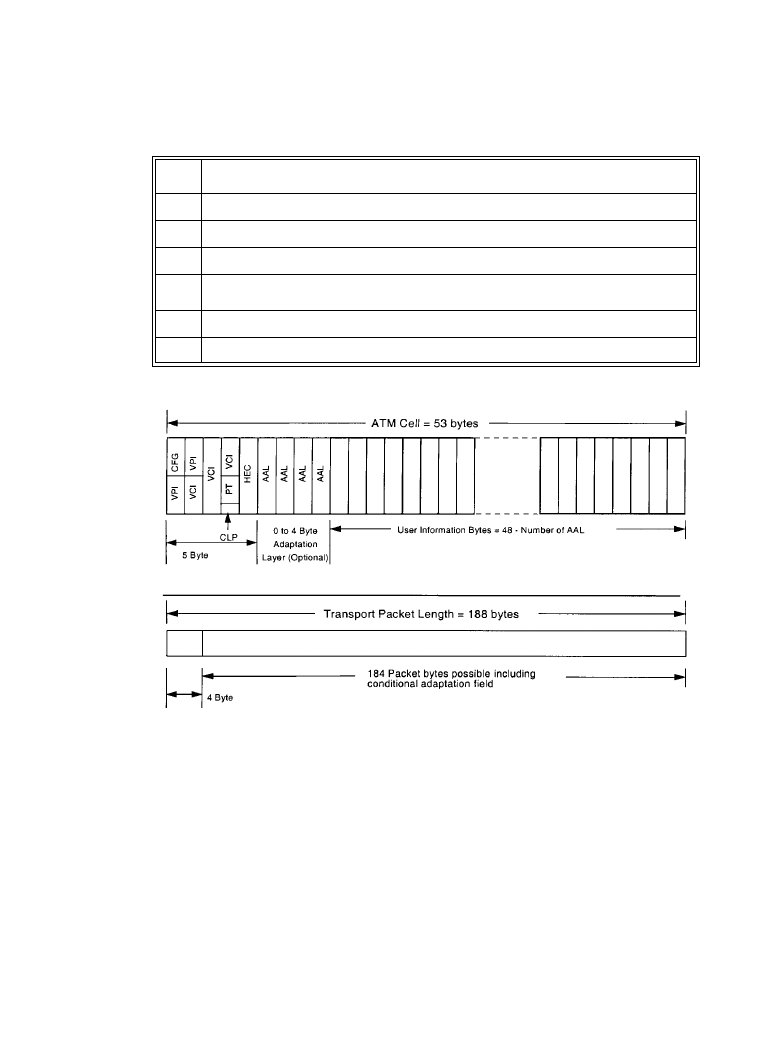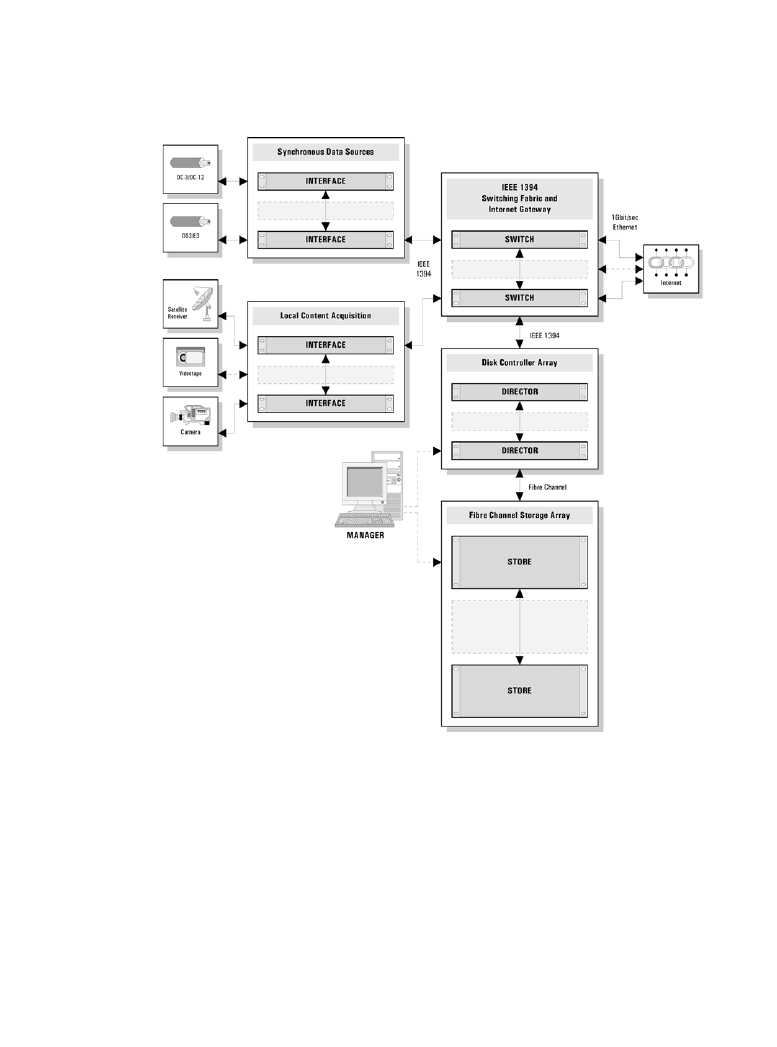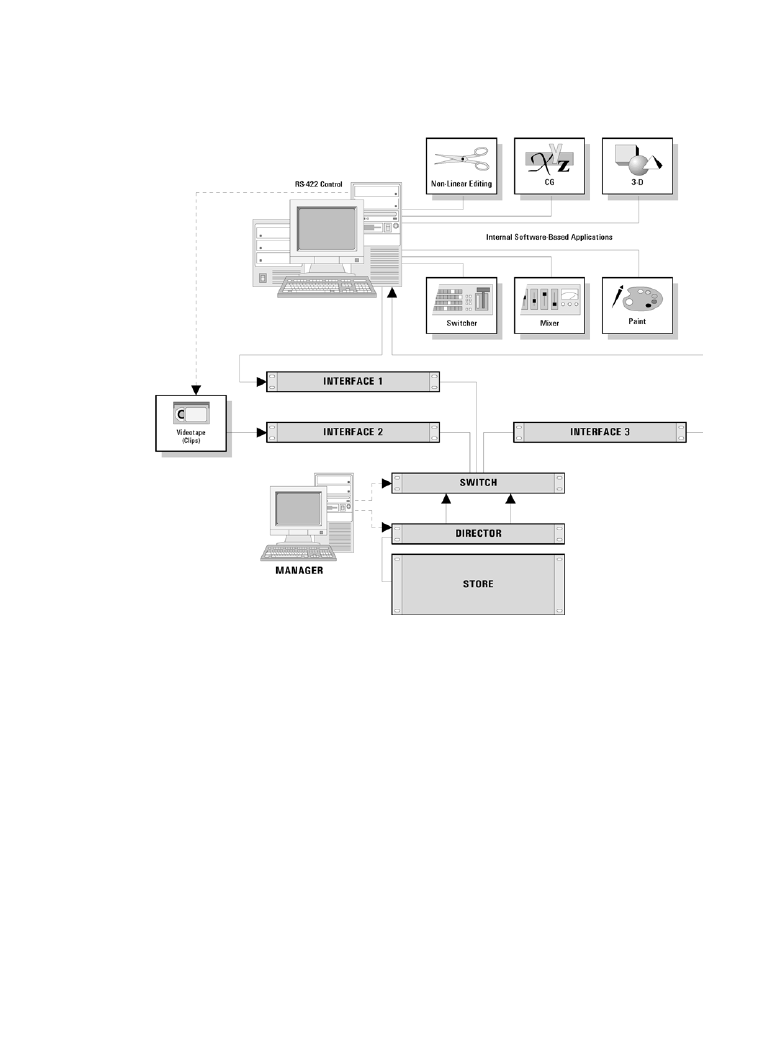ВУЗ: Казахская Национальная Академия Искусств им. Т. Жургенова
Категория: Книга
Дисциплина: Не указана
Добавлен: 03.02.2019
Просмотров: 21735
Скачиваний: 19

8-38 Audio Networking
channel rates required by other network protocols. Because the connections supported are either
permanent or semipermanent and do not require call control, real-time bandwidth management,
or processing capabilities, ATM has the flexibility for video/multimedia applications.
The ATM cell header, the key to the use of this technology for networking purposes, consists
of the fields shown in Table 8.3.1. Figure 8.3.3 illustrates the differences between the format of
an ATM cell and the format of the MPEG-2 transport packet.
Table 8.3.1 ATM Cell Header Fields
(
After [1].)
GFC
A 4-bit
generic flow control
field: used to manage the movement of traffic across the user net-
work interface (UNI).
VPI
An 8-bit network
virtual path identifier
.
VCI
A 16-bit network
virtual circuit identifier
.
PT
A 3-bit
payload type
(i.e., user information type ID).
CLP
A 1-bit
cell loss priority
flag (eligibility of the cell for discard by the network under congested
conditions).
HEC
An 8-bit
header error control
field for ATM header error correction.
AAL
ATM
adaptation-layer
bytes (user-specific header).
(
a)
(
b)
Figure 8.3.3
Comparison of the ATM cell structure and the MPEG-2 transport packet structure: (
a)
structure of the ATM cell, (
b) structure of the transport packet. (After [3].)
Downloaded from Digital Engineering Library @ McGraw-Hill (www.digitalengineeringlibrary.com)
Copyright © 2004 The McGraw-Hill Companies. All rights reserved.
Any use is subject to the Terms of Use as given at the website.
Video/Audio Networking Systems

Video/Audio Networking Systems 8-39
8.3.3
IEEE 1394
IEEE 1394 is a serial bus interconnection and networking technology, and the set of protocols
defining the communications methods used on the network [4]. IEEE 1394 development began
in the 1980s at Apple Computer and was trademarked under the name FireWire. Sony has since
trademarked its implementation as iLINK. The formal name for the standard is IEEE 1394-1995.
IEEE 1394 is widely supported by hardware, software, and semiconductor companies where
it is implemented on computers, workstations, videotape recorders, cameras, professional audio,
digital televisions and set top boxes, and consumer A/V equipment. 1394 enables transfers of
video and data between devices without image degradation. Protocols for the transport of video,
digital audio, and IP data are in place or under development at this writing. The EBU/SMPTE
Task Force for Harmonized Standards for the Exchange of Program Material as Bit Streams has
recognized IEEE 1394 as a recommended transport system for content.
Like other networking technologies, 1394 connects devices and transports information or data
among the devices on a network. When IEEE 1394 was developed, the need to transport real-
time media streams (video and audio, for example) was recognized. These signal types require
consistent delivery of the data with a known latency, i.e., isochronous (constant or same time)
delivery.
8.3.3a
Operating Modes
When transmitting time sensitive material, such as real-time motion video, a slight impairment
(a defective pixel, for example) is not as important as the delivery of the stream of pictures mak-
ing up the program [4]. The IEEE 1394 designers recognized these requirements and defined
1394 from the outset with capabilities for isochronous delivery of data. This isochronous mode is
a major differentiator of IEEE 1394 when compared with other networking technologies, such as
Ethernet, Fibre Channel, or ATM.
IEEE 1394 divides the network bandwidth into 64 discreet channels per bus, including a spe-
cial broadcast channel meant to transmit data to all users. This allows a single IEEE 1394 buss to
carry up to 64 different independent isochronous streams. Each stream can carry a video stream,
audio stream, or other types of data streams simultaneously. A network resource manager allo-
cates bandwidth and transmission channels on the network to guarantee a fixed bandwidth chan-
nel for each stream.
IEEE 1394 also supports asynchronous transmissions. The asynchronous channels are used to
transmit data that cannot suffer loss of information. This dual transmission scheme, supporting
both isochronous and asynchronous modes, makes IEEE 1394 useful for a range of applications.
8.3.3b
Data Rates and Cable Lengths
IEEE 1394 defines a set of parameters to assure reliable system operation. The initial standards
called for data rates of 100 and 200 (nominal) Mbits/s. IEEE 1394a increased the data rate to 400
Mbits/s. IEEE 1394b increases data rates to 800 Mbits/s, 1.6 Gbits/s, and 3.2 Gbits/s. At 400
Mbits/s, the isochronous payload size is 4096 bytes—considerably larger than other technolo-
gies, such as ATM. As the clock speed increases, the size of the data packets increase linearly.
Typical applications of IEEE 1394 are shown in Figures 8.3.4 and 8.3.5.
Downloaded from Digital Engineering Library @ McGraw-Hill (www.digitalengineeringlibrary.com)
Copyright © 2004 The McGraw-Hill Companies. All rights reserved.
Any use is subject to the Terms of Use as given at the website.
Video/Audio Networking Systems

8-40 Audio Networking
8.3.3c
Isochronous and Asynchronous Transmissions
At first glance, the terms isochronous and synchronous, as applied to network transmissions,
describe essentially the same process. Upon further investigation, however, small but significant
differences emerge [6, 7].
An isochronous channel has a constant time interval (or integer multiples thereof) between
similar “significant instants.” This basic definition means that each isochronous packet in a
Figure 8.3.4
The application of IEEE 1394 in a large scale internet broadcast environment. (
From
[5].
Used with permission.)
Downloaded from Digital Engineering Library @ McGraw-Hill (www.digitalengineeringlibrary.com)
Copyright © 2004 The McGraw-Hill Companies. All rights reserved.
Any use is subject to the Terms of Use as given at the website.
Video/Audio Networking Systems

Video/Audio Networking Systems 8-41
stream begins a constant time interval after the previous packet in that stream. In IEEE 1394, iso-
chronous packets begin 125
µs apart (at least on average). This period is controlled by a clock
packet, transmitted by the IEEE 1394 bus master, which signals devices on the network that it is
time to send the next isochronous packet. Another example of an isochronous channel is the 270
Mbits/s serial digital video interface, where a line of video begins every 64
µs (625/50) or 63.56
µs (525/60).
The opposite of isochronous is anisochronous. An anisochronous channel does not maintain
constant time intervals between significant instants. A good example of this is Ethernet, a tech-
nology that does not synchronize data transmission from nodes on the network, but instead relies
on signaling when conflicts occur.
The term synchronous refers to a timing relationship between two different channels. If two
“significant instants” (e.g., packet starts) on two different channels occur at the same time every
time, the channels are synchronous. A good example of synchronous channels would be a 4:2:2
Figure 8.3.5
The application of IEEE 1394 in a nonlinear postproduction environment. (
From [6].
Used with permission.)
Downloaded from Digital Engineering Library @ McGraw-Hill (www.digitalengineeringlibrary.com)
Copyright © 2004 The McGraw-Hill Companies. All rights reserved.
Any use is subject to the Terms of Use as given at the website.
Video/Audio Networking Systems

8-42 Audio Networking
4:4 SDI signal carried on two coaxial cables, where lines of video are completely time aligned on
the two cables.
The opposite of synchronous is asynchronous. If “significant instants” on two channels do not
consistently line up, then the channels are asynchronous.
8.3.4
Fibre Channel
Fibre Channel is a 1 Gbits/s data transfer interface technology that maps several common trans-
port protocols, including IP and SCSI, allowing it to merge high-speed I/O and networking func-
tionality in a single connectivity technology [4]. Fibre Channel is an open standard, as defined by
ANSI and OSI standards, and operates over copper and fiber optic cabling at distances of up to
10 km. It is unique in its support of multiple inter-operable topologies—including point-to-point,
arbitrated-loop, and switching—and it offers several qualities of service for network optimiza-
tion.
Fibre Channel first appeared in enterprise networking applications and point-to-point RAID
and mass storage subsystems. It has expanded to include video graphics networks, video editing,
and visual imaging systems.
Fibre Channel Arbitrated Loop (FC-AL) was developed with peripheral connectivity in mind.
It natively maps SCSI (as SCSI FCP), making it a powerful technology for high-speed I/O con-
nectivity. Native FC-AL disk drives allow storage applications to take full advantage of Fibre
Channel's gigabaud bandwidth, passing SCSI data directly onto the channel with access to multi-
ple servers or nodes. FC-AL supports 127-node addressability and 10 km cabling ranges
between nodes. (See Table 8.3.2.)
The current specification for FC-AL allows for 1, 2 and 4 Gbits/s speeds. At this writing,
practical applications of the technology are at the 2 Gbits/s rate.
Fibre Channel is designed with many high-availability features, including dual ported disk
drives, dual loop connectivity, and loop resiliency circuits. Full redundancy in Fibre Channel sys-
tems is achieved by cabling two fully independent, redundant loops. This cabling scheme pro-
vides two independent paths for data with fully redundant hardware. Most disk drives and disk
arrays targeted for high-availability environments have dual ports specifically for this purpose.
8.3.5
Gigabit Ethernet
The Ethernet protocol is the dominant networking technology for data processing applications.
Gigabit Ethernet adds a 1 Gbit/s variant to the existing 10 and 100 Mbits/s Ethernet family while
retaining the Ethernet standard frame format, collision detection system, and flow control. For
reasons of compatibility with traditional data processing systems and the wide bandwidth neces-
sary for digital video, Gigabit Ethernet has emerged as a viable method of transporting video
within a facility [8].
The basic Ethernet performance specifications are given in Table 8.3.3 for the minimum 46
data byte and the maximum 1500 data byte frames [9]. Gigabit Ethernet was standardized for
fiber optic interconnection in July 1998, and a copper specification using 4 pairs of category 5
unshielded twisted pair (UTP) was released about a year later.
Downloaded from Digital Engineering Library @ McGraw-Hill (www.digitalengineeringlibrary.com)
Copyright © 2004 The McGraw-Hill Companies. All rights reserved.
Any use is subject to the Terms of Use as given at the website.
Video/Audio Networking Systems